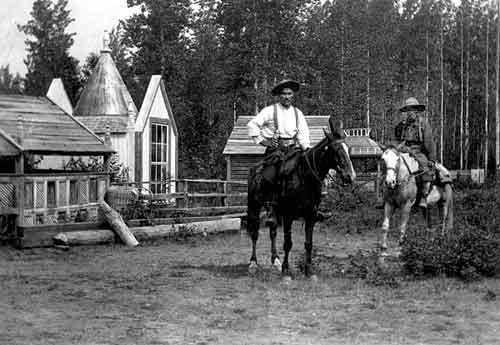Did You Know?
That a sea monster dubbed Cadborosaurus allegedly haunts the waters of the south coast. The serpent-like creature, up to 20 metres in length, is named for Victoria's Cadboro Bay, where it was first spotted in 1933.
That in 1910 the king of the Hollywood horror film, Boris Karloff, was working in Vancouver as a carpenter while he struggled to get his acting career going.
That the earliest Hagwilget Bridge across the Bulkley River, built by the Wet'suwet'en people out of rope and wood long before the arrival of the first Euro-Canadians, has been replaced several times until today it is a single-lane steel and cable suspension bridge 80 metres above the river.
That the Giant Pacific Octopus that inhabits the coastal waters of BC is the largest octopus in the world; one has been caught weighing 270 kilograms with an armspan of almost 10 metres.
That the Nakwakto Rapids on the mainland opposite the north end of Vancouver Island have the fastest navigable tidal currents in the world, up to 30 kilometres an hour.
That Simon Gunanoot, a Gitksan trapper accused of murder, remained on the run from the law for thirteen years (1906-1919) before he finally gave himself up, stood trial and was acquitted. He is the most famous fugitive in BC history.

That a geoduck (pronounced "gooey-duck"), the largest clam species on the coast, can weigh as much as five kilograms and live up to 150 years.
That British Columbia had its own navy – for three days! In 1914 Premier Richard McBride, fearing an attack by German warships, purchased two submarines in Seattle to defend the coast.
That the BCP45, a wooden fishing boat now in the collection of the Maritime Heritage Centre in Campbell River, was featured on the Canadian $5 bill from 1972 to 1986.
That there were 17 First Nations residential schools in BC.
That the cartoon-strip magician called Mandrake was based on Leon Mandrake, a real-life stage magician from New Westminster.
That camels were used to pack supplies to the gold fields of the Interior during the Cariboo Gold Rush.
That BC’s own Kim Campbell, prime minister of Canada in 1993, is the only woman ever to serve as the country’s leader.
That Larry Walker, from Maple Ridge, became the first Canadian to be named most valuable player in major league baseball, in 1997.
That British Columbia was known as New Caledonia to the early fur traders.
That the Canadian Pacific imported about 6,500 Chinese laborers to build its rail line through the interior of BC 1880-1885; these immigrant workers got the most dangerous jobs and at least 600 of them died.
That BC once had its own language, Chinook Jargon, consisting of words and phrases adapted from different First Nations languages, English and French; at its height the language was spoken by 250,000 people.
That Larry Kwong, from Vernon, was the first Chinese Canadian to play in the National Hockey League when he joined the New York Rangers for a game in 1947.
That 65 percent of the population of BC lives in the basin of the Fraser River, the longest river wholly within the province.
That the Rocky Mountain Trench, almost 1,400 km long, is the longest valley in North America.
That the 2010 Winter Olympics in Vancouver/Whistler was the third time Canada has hosted the Olympics after Montreal in 1976 and Calgary in 1988.
That a large sea serpent known as Ogopogo is believed to inhabit the depths of Okanagan Lake
That the term Lotus Land, often used to describe the laid back lifestyle of British Columbians, was coined by journalist Bruce Hutchison in 1943.
That the phrase Great Bear Rainforest was conceived by environmental activists Peter McAllister and his son Ian in the early 1990s to describe the central and north coast.
